Yea, say that ten times fast!
So, a few weeks ago the brains for my automated low pressure valve fried. A bug crawled in and got toasted between a couple transistors in the H-bridge and the smell of burnt electronics ensued. I did manage to get it working again for a day but then it quit. I’ve never managed to get the backup circuit board working right and I’ve exploded several capacitors in the process so……. I set the system to run constant flood for the week I was out of town and when I got back I started testing a new idea.
What if a FLOUT® could be used to feed a gravity modified indexing valve? What a grand idea that would be.
Well now we wade into reality of trying to balance flows and provide enough pressure to an indexing valve (even a gravity modified indexing valve needs a certain amount of “gush” to engage properly.) A FLOUT® needs a certain amount of unrestricted outflow for a given inflow for it to be able to re-float too.
Well I was testing this out in a pre-existing system with fish tank and beds already in place so I couldn’t really mess with the heights to get more pressure to my indexing valve. I had it almost working, almost. Little things like the long pipe run from the indexing valve to the furthest bed were actually messing things up!!! That is how close it was to working. If only I had just a little more height to work with, I’m sure I would have been golden!!!!
But anyway, being that I need to get something in place and functioning quickly so I can have it tested/tweeked for a while before I have to travel again. I gave in and installed a pump to drive the indexing valve.
Hence the pumperflouternating bit. See, I didn’t remove the FLOUT® from the situation. I simply added a pump to feed the indexing valve and the flout is still handling the overflow to feed the overflow beds. This is actually a great improvement as the way it was before the overflow beds were getting a constant inflow and this was causing sliming problems in the beds. Now they get intermittent flow (all be it quite often, as those three beds get water flow for about 4 minutes of every 10 minutes.)
So how it is working now. There is a FLOUT® tank (100 gallon stock tank) right next to the fish tank getting the outflow from the fish tank. Inside that tank is a 3″ FLOUT® with it’s out let connected to feed the 3 overflow grow beds. And then I added a Quiet One 6000 pump (happens to be the one I had on hand of large enough size to drive a 1 1/2″ indexing valve.) Now I found that connecting the pump directly to the indexing valve actually caused a problem since when the pump turned off the water would continue siphoning (at first I thought the timer was bad.) So, I had to make sure there was a air break up above the pump but high enough that water wouldn’t be shooting out overhead.
So the PLART continues. PLART is what happens when you use whatever plumbing bits are left over from old projects that have been cut up.
So moving on. It should be noted that a FLOUT® has a certain working flow rate (far wider than most siphons but there are still limits.) My inflow to my fish tank is quite fast. I like to move lots of water to keep the aeration up and water quality good. A 3″ FLOUT® will not re-float if there is more than about 28 gpm going to it or less if there is a restriction on the outflow like an indexing valve. Luckily I changed things and added the pump. The pump is in the FLOUT® tank and running on a repeat cycle timer pumps for about 4 minutes which amply floods a grow bed through the indexing valve. Then the pump turns off for about 5 minutes which allows the water level in the FLOUT® tank to rise enough that the FLOUT® then sinks and flows water to the overflow beds for about 4 minutes. My inflow to the fish tank I must have set to about 30 gpm because the FLOUT® doesn’t re-float until the pump comes back on and uses some of the flow rate allowing the FLOUT® to float.
So, I’m alternating between the FLOUT® and the pump to have timed flood and drain for all my beds! Yay. I just wish I had been able to manage it without needing to use the extra pump but I guess that will have to wait for a complete system build to get the heights right.

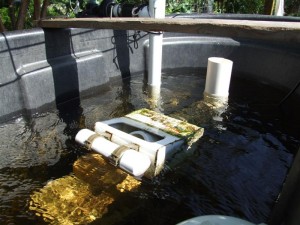
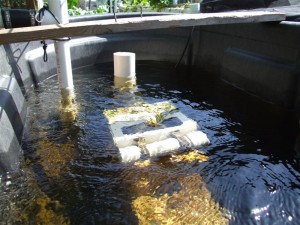
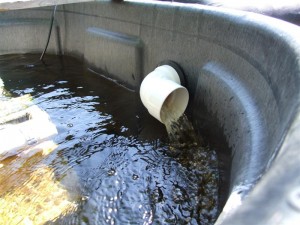
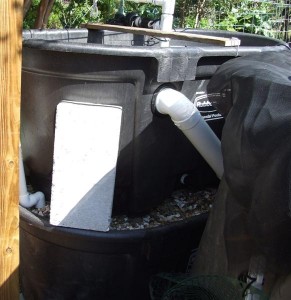
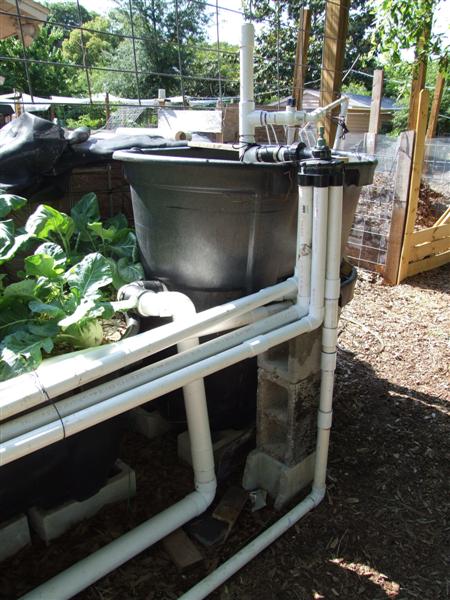
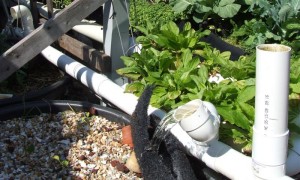
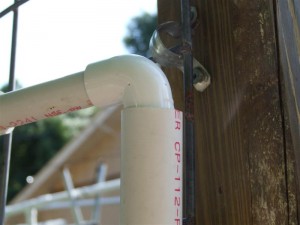
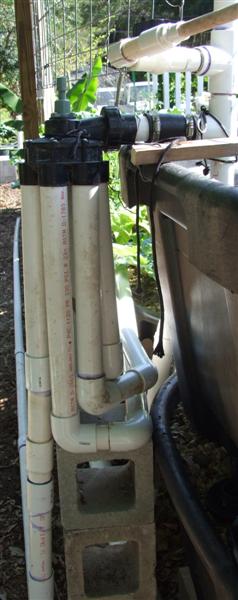



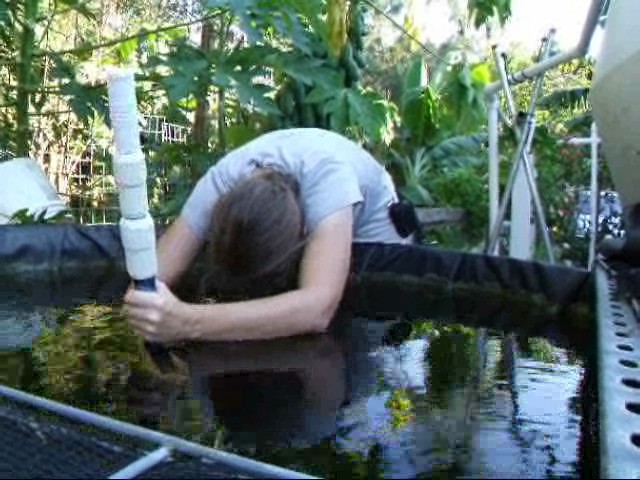
TC, our systems are starting to have parts that look alike!
I had Rissy build me a FLOUT type FL-2131M, the “M” stands for Magnet, it’s the first of its kind. I have mounted it in a 100-gallon RMST as well. This FLOUT-chamber will sit at the same height as all growbeds.
Water flow here is Pump > Indexing Valve > Growbed > FLOUT Chamber > drain to Sump.
The FLOUT lands on a Tee of 1-inch PVC where the (magnet actuated) reed switch will live. The leg of the Tee goes out the wall of the RMST thru a UniSeal so the wires inside stay nice and dry.
Tests will be run on using the reed switch to shut off the pump whenever the FLOUT hits bottom. Also want to try the switch actuating a nice big relief valve Tee’d right before the indexing valve (which lets the pump run full time).
Jim put a stack of strong magnets on each side of the pipe in the FLOUTbox; it closes a reed switch when it gets within an inch of the switch. So the switch could theoretically be placed under the chamber; I put it in a pipe since I needed a landing pad anyway and it’ll be a lot easier to access the wiring there (just drain the chamber).
So: using the FLOUT technology downstream instead of above the GBs, therefore the heights are all “down to earth” but there is some wiring logic to deal with. I’ll let you know how it goes.
Wow, my post looks crazy…
Regarding the pumperflouternation… I must admit I probably never would have thought of throwing a little pump in the FLOUT chamber.
Not that my imagination is underactive: I have thought of filling the non-busy half with media or (big bags of) activated charcoal. I have toyed with the idea of running a small tube from inside the floatybox, thru the main drain pipe, up to the inner tube of a GB’s bell siphon (to force the FLOUT down whenever that GB drains). I repaired a leak in a RMST and when it reappeared, I actually thought “cool, I can catch that drippage and run it over to my blackberry patch!”